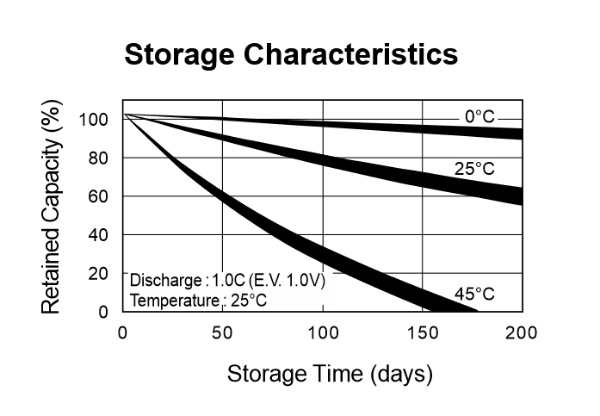Both Nickel Cadmium batteries and Nickel Metal Hydride batteries can be stored in similar conditions.
Temperature
Nickel based batteries are more flexible than many other battery types.
- The ideal storage temperature is 50°F (10°C).
- The minimum storage temperature is -4°F (-20°C).
- The maximum storage temperature is 113°F (45°C).
However as with all batteries the higher the temperature the faster the battery will discharge. The graph below, from UK firm GP Batteries shows the results of tests on Nickel Cadmium batteries stored at different temperatures.

As we can see at 113°F (45°C) the battery was fully discharged within 180 days while storage at 32°F (0°C) meant it was still near full capacity after 200 days. However 32°F (0°C) is not recommended as Nickel Cadmium batteries are water based and in a fully discharged state this may freeze leading to possible internal or external damage. Hence 50°F (10°C) is the suggested compromise – comfortably above zero to avoid the risk of freezing but not so hot as to cause rapid discharge in storage.
Humidity
- The ideal storage humidity is 50%
The main issue with humidity is that condensation can build up both inside and outside the battery. If it does so internally the unit can be permanently damaged. Externally the terminals of some battery types start to rust making it more difficult to establish a strong connection when put into use.
Charge
All batteries gradually discharge even when in storage but Nickel based batteries can be fully discharged without damage. In this event it is recommended to prime the battery (fully charge and discharge it several times) to regain full capacity.However if you want to ensure the battery is ready for immediate use it is best to keep it at around 40-50% State of Charge (SoC) and some manufacturers recommend a full charge at least once a year.
Note measuring SoC is difficult on this type of battery as temperature and any recent activity (discharge or recharge) will affect voltage readings so the recommended test is as follows:
- Ensure the battery has not been charged or discharged in the last four hours.
- Make sure it is at room temperature (leave it to stand for several hours or overnight if it has been in a cold environment).
- Use a voltmeter to check the voltage and charge if the voltage reading is below the batteries stated voltage.
Nickel based batteries can be damaged by overcharging as water is vented out in the form of gas and cannot be replaced leading to a loss of capacity.
Shelf Life
The following guidance is based on batteries that are kept at the right temperature, the right humidity and in the correct State of Charge. Under these conditions Nickel Metal Hydride battery can have a shelf life of between 1 and 3 years and a Nickel Cadmium between 2 to 3 yrs.
Related Articles:


Leave A Comment?